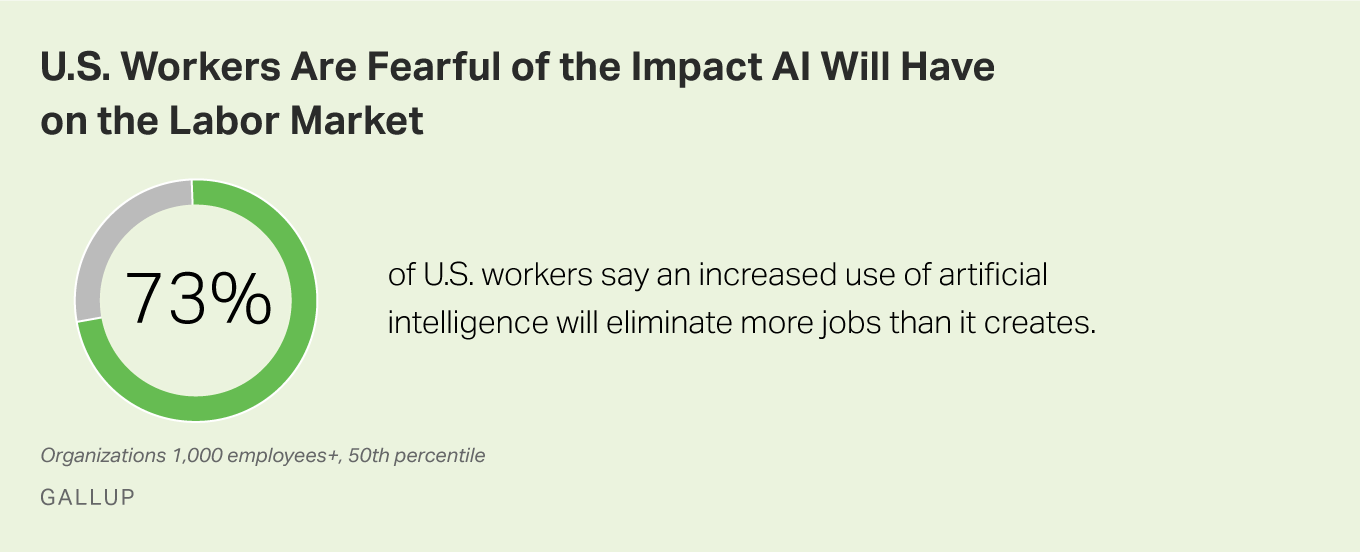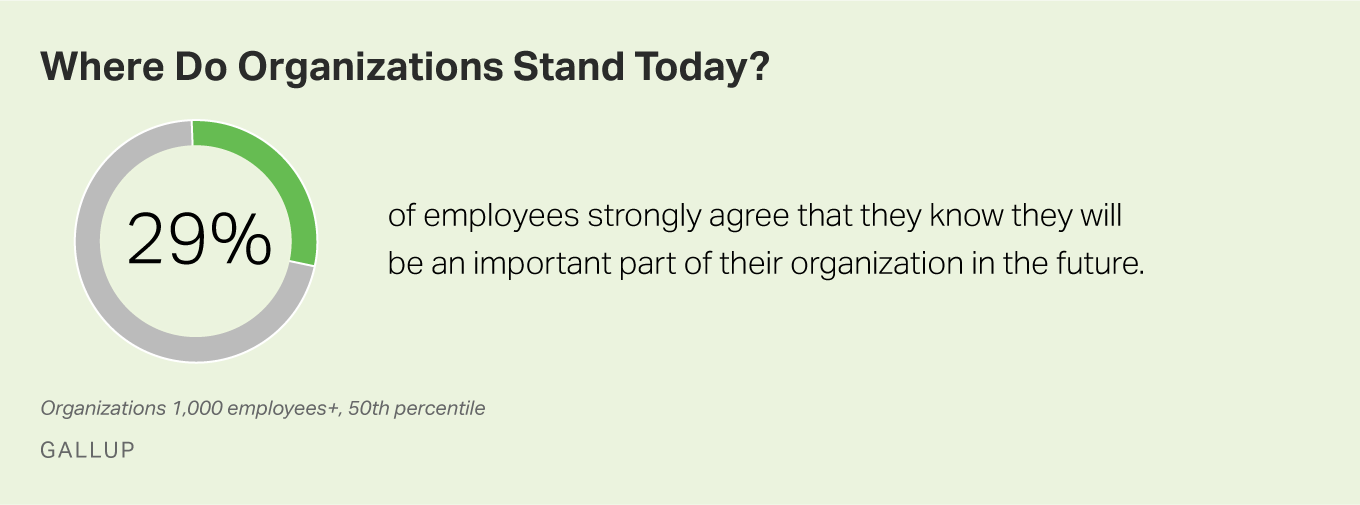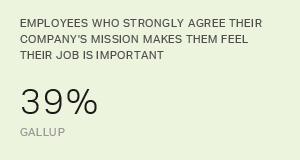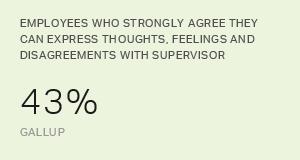Story Highlights
- Successful AI implementation requires a rush into an uncertain future
- Leaders must align everyone's long-term interests
- Doing things right is as important as not doing things wrong
Workers worry about what AI will do to their jobs -- and with good reason. Experts believe AI will replace 800 million jobs over the next 13 years, and 73% of workers in the U.S. say an increased use of AI will eliminate more jobs than it creates. In fact, 23% of U.S. workers tell Gallup they're "very worried" or "somewhat worried" they might lose their own job to new technology.

Clearly, this sentiment poses a challenge to companies looking to engage their workforce over the course of their digital and, subsequently, AI transformation journey. In essence, employees will be asked to conceive, drive and implement projects that will potentially eliminate or overhaul their jobs. Conflicts of interest are inevitable, resulting in a well-trod path toward change initiative failure and barriers to productivity and growth.
Consider Europe, where employee representation bodies like labor unions and work councils have started trying to institute barriers to the adoption of AI technology in an attempt to protect employees' livelihoods. The result may be severe damage to overall competitiveness in the market, even if that isn't the employees' intention.
This is a cautionary tale of how AI-powered transformation will turn into an exhausting uphill battle for organizations that fail to secure their employees' buy-in. And without employee involvement, companies lose local in-depth knowledge that is crucial for the early stages of new tech implementation.
Think about the executive assistant who puts a great deal of time and pride into setting meetings. He coordinates schedules masterfully, juggling time and distance constraints with a nuanced understanding of personal preferences -- Jamie can't stand plastic water bottles, Ramon and Sinya are too competitive to sit facing to each other -- and he always gets people what they need. He carefully crafts every invitation, reminder and follow-up note to boost participation and productivity. He knows he's integral in keeping the business afloat. Now tell him that this task is going to be taken over by a scheduling app, and ask him to populate it with the details only he knows. Imagine his response.
Actually, we don't have to imagine it; we've seen this play out before: Luddites destroying the looms that took their jobs or autoworkers sabotaging machinery that accelerated the pace of production, making their work stressful and unendurable. Someone even destroyed "hitchBOT," the smiling Canadian robot that hitchhiked across much of Canada and Europe before being beheaded in Philadelphia.
And hitchBOT didn't even displace any jobs. The machinery that does may well be met with resistance, as it has been before. But the scale of change and unpredictability that AI-based business models are likely to bring is bigger than any we've seen since the home computer revolution -- and probably bigger. Leaders, together with their employees, will need to discover and invent solutions that work for them.
The Same Boat
Solutions that work for them, developed by them. A successful, full-hearted AI transformation journey will require a willing rush into an uncertain future, like sea-faring explorers of old. Neither the captain nor the crew truly knew their destination, but they had faith they'd all look after each other's interests as they move toward the unknown. They knew they were all in the same boat.
This is precisely the sentiment organizations should seek to replicate if they want to transform with their employees, not despite them.
Are we in the same boat?

Leaders can foster this sentiment by aligning the employees' and the organization's interests without abusing authority. After all, it's not a given that AI will have an adverse impact on employees. It may increase productivity and create new value opportunities -- enough to cover the downside for the stakeholders involved, anyway.
A Win-Win Mindset
However, leaders will have to redesign structures and systems to get stakeholders to believe that. Career management plans, comprehensive learning and development support, early retirement arrangements and many other thoughtful considerations should be a part of the solution. "Damage control" is insufficient, so leaders will have to find ways for employees to enjoy the benefits of the AI-generated business growth.
Still, workers' willing buy-in depends on their level of trust. Companies must establish a positive track record of using new technologies to benefit both the business and the employees. Here, doing things right is as important as not doing things wrong.
The booming industry of people analytics provides a good example of this. People analytics has the potential for making better, evidence-based HR decisions, reducing bias, minimizing bureaucracy, and improving individual and team performance.
However, when applied incorrectly, people data analytics programs can feed the fear of a "big brother" workplace environment, in which employee actions are watched, recorded and judged. Some companies are excited about an ability to predict employee turnover down to the individual level by analyzing employees' online behavior (e.g., LinkedIn usage) or time off patterns (such as taking a Wednesday off, because that's believed to be done for a job interview). These behaviors might serve as good predictors for a while -- until employees notice and start searching for jobs on their smartphones and scheduling their interviews on Fridays.
Such practices undermine employee trust, engagement and loyalty to the organization. They signal to employees that their leaders will apply all means available to advance the business -- even if it means establishing a zero-sum system and compromising respect and trust. That's how a company destroys engagement, not how it builds a win-win mindset.
Instead, if concerned about turnover, organizations are better off identifying and using win-win retention levers that benefit both the organization and the employees -- for example, engaging leadership, growth and development opportunities or allowing for flexible working arrangements.
Companies surely need to build their data-driven decision-making capabilities to enable the AI-transition, but they need to do so by advancing, not compromising, the culture of trust and care for employees' overall well-being.
That is essential, but just one, aspect of the culture changes companies need to make to thrive in an AI-business world. For a full overview, look for the last article in this series.
Consider the following questions to probe your organization's readiness for the AI-powered business environment:
Do interactions with your employee representative bodies resemble "us vs. them" scenarios?
Does your organization have an active strategy for supporting the overall well-being of your employees?
How worried would you be if the contents of the research plan of your people analytics team were to be made known to all employees?
Read the first, second, third, fourth and fifth articles in this compelling seven-part series. The next and final article will provide a full overview of the series.
Discover how your company can create a performance management system that helps your employees become better prepared for the AI era:
- Register for our on-demand webinar on how to achieve cultural transformation.
- Download Gallup's perspective paper on culture to learn how to build a business that's ready for the future.
- Discover what Americans think about -- and what they can do to confront -- the AI revolution.



